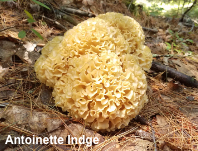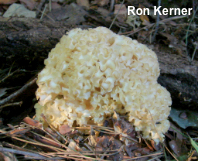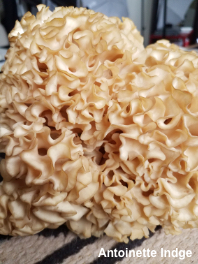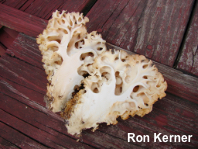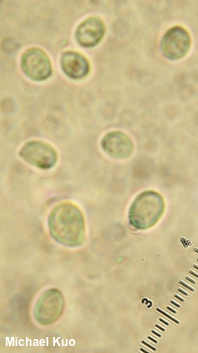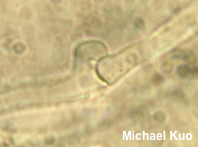| Major Groups > Clubs & Corals / Polypores > Sparassis > Sparassis americana |

|
Sparassis americana [ Basidiomycota > Polyporales > Sparassidaceae > Sparassis . . . ] by Michael Kuo Found east of the Great Plains under pine trees, this Sparassis species looks like a large clump of tightly packed egg-noodles. The "noodles" have curly edges, and arise from a shared fleshy base that sometimes roots into the ground. Sparassis americana is very similar to the Pacific Northwest's Sparassis radicata, but the two are not likely to be confused since their ranges are separated by more than 1000 miles. A form of Sparassis americana is found, however, in the southwestern United States under Ponderosa pines. While not a separate species, it is geographically and ecologically distinct, and bears the official name of Sparassis americana f. arizonicus. Compare Sparassis americana with Sparassis spathulata, which is also found east of the Great Plains; the latter species features straighter, flatter, less "noodly" branches, and is fond of oaks as well as pines. Additionally its branches are often zoned with color shades, and, under the microscope, its flesh lacks clamp connections. Until fairly recently, most North American authors used the name "Sparassis crispa" to refer to Sparassis americana and/or Sparassis radicata. However, DNA studies (e.g. Hughes et al. 2014) indicate that Sparassis crispa, originally described from Austria, is a strictly European phylogenetic species associated with Scots pine, and that our North American species is distinct. Thanks to Antoinette Indge and Ron Kerner for documenting, collecting, and preserving Sparassis americana for study; their collections are deposited in The Herbarium of Michael Kuo. Description: Ecology: Pathogenic and saprobic; growing from the roots or bases of trees; found under pines (species of Pinus, with bundled needles); annual, but often recurring yearly in the same location; causing a brown rot or a butt rot; summer and fall; originally described from Tennessee; fairly widely distributed in North America east of the Great Plains, and in the southwestern United States (f. arizonica), but apparently rare or absent from the Gulf Coast and Florida. The illustrated and described collections are from Indiana and Massachussetts. Fruiting Body: 9–25 cm across; up to 15 cm high; composed of tightly packed, noodle-like branches which arise from a common, fleshy basal structure that is sometimes underground; branches thin-fleshed, whitish to yellowish or brownish, evenly colored, bald; flesh whitish, unchanging when sliced. Odor and Taste: Not distinctive. Microscopic Features: Spores 3–5 x 2.5–4 µm; ellipsoid, broadly ellipsoid, or sublacrymoid; smooth; hyaline in KOH; inamyloid. Basidia 28–32 x 3.5–5 µm; subclavate; 4-sterigmate. Cystidia not found. Contextual hyphae 4–8 (–10) µm wide; smooth; hyaline in KOH; clamp connections present. REFERENCES: R. H. Petersen, 2014. (Coker, 1921; Martin & Gilbertson, 1976; Burdsall & Miller, 1988a; Burdsall & Miller, 1988b; Lincoff, 1992; Metzler & Metzler, 1992; Wang et al., 2004; Light & Woehrel, 2009; Hughes et al., 2014; Woehrel & Light, 2017; Elliott & Stephenson, 2018; Sturgeon, 2018.) Herb. Kuo 09140901, 07121901. This site contains no information about the edibility or toxicity of mushrooms. |
© MushroomExpert.Com |
|
Cite this page as: Kuo, M. (2021, June). Sparassis americana. Retrieved from the MushroomExpert.Com Web site: http://www.mushroomexpert.com/sparassis_americana.html |
